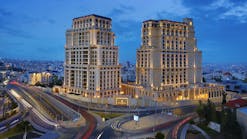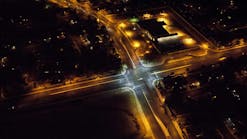The LED luminaires generally offered higher efficacy, more appropriate luminous intensity distribution and better color quality. However, the calculated payback period when luminaires are purchased in volume is just less than 10 years. This is not uncommon, as a separate Gateway demonstration program in New York estimated a payback period of 8-16 years for tested roadway luminaires from four manufacturers.
In addition to performance and economic feasibility data, the report also includes feedback collected from local Illuminating Engineering Society (IES) members who toured the site. Although the responses varied, the 38 IES members generally preferred the color quality offered by areas lit by the induction luminaire and one LED luminaire (B and C), while they did not favor the color quality offered by the HPS luminaire (F). Area C was also perceived as brighter and more uniform than the other areas, which matched the measurements; however, it had the highest average rating for glare and some respondents commented that there was too much light trespass. The report is available for download at the DOE website.
Roadway luminaire comparison
This report notes that some of the alternative luminaires did not provide sufficient illumination to all areas, including vehicular drive lanes, bicycle lanes, and sidewalks. In some cases, the LED luminaires would likely fail to meet design criteria over the life of the installation because of expected depreciation in lumen output.
A networked control system was installed on all luminaires and recorded power values were compared to spot measurements and the manufacturer reported values. While most power measurements were consistent with their expected values, one LED luminaire was substantially lower. The report notes that accuracy in reported values is essential because utilities often base tariffs on rated power. Discrepancies between rated power and measured power have been noted on several Gateway reports.
A simple payback analysis that included melded electricity cost ($0.09031/kWh), energy use and estimated maintenance cost revealed a shortest payback period of 17.3 years for the LED luminaires. Because this payback is affected greatly by the purchase price associated with low-volumes of luminaires, a recalculation was performed using prices more typical of higher-volume purchases, which shortens the payback period to less than 10 years. The City of Portland requires a 10-year payback period for all energy-efficiency projects.
In February of this year, the DOE Municipal Solid-State Street Lighting Consortium released its Retrofit Financial Analysis Tool, an Excel-based spreadsheet that helps cities and utilities estimate the cost and benefit of switching to LED-based street lighting using current prices. The tool is available for download at www.ssl.energy.gov/financial-tool.html.
Future roadway studies
The Pacific Northwest National Laboratory (PNNL) and Gateway program will continue to monitor and report on problems with this Portland installation. NE Cully Boulevard is intended to be the site of long-term testing and evaluation projects. Potential future investigations are likely to focus on monitoring luminaire performance, evaluating adaptive lighting techniques, generating long-term data on environmental conditions and energy use, and full demonstration of the capability, performance, and reliability of the control system. The results of future studies will be released in a supplemental Gateway report.







